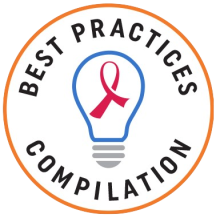The Brandy Martell Project was implemented by the TransVision program at the Tri-City Health Center (now known as Bay Area Community Health), a community health center providing transgender health care to more than 300 low-income transgender people in the San Francisco Bay Area. From 2013 to 2017, The Brandy Martell Project aimed to engage adult transgender women of color in HIV care and increase retention in care by offering patient navigation services, workshop programming, and legal support. Evaluation results showed The Brandy Martell Project had a significantly positive effect on antiretroviral therapy (ART) prescription for clients.
San Francisco Bay Area, CA
Although transgender women served by the Ryan White HIV/AIDS Program (RWHAP) are retained in care at similar rates to all RWHAP clients, transgender women continue to have lower rates of viral suppression.1 This lower rate of viral suppression for transgender women remains true in the San Francisco Bay Area in California. Transgender women of color face a multitude of barriers in accessing HIV care, including systemic racism and discrimination, higher rates of poverty and homelessness, transphobia, distrust of medical providers, and stigma. The Brandy Martell Project, which aimed to address these issues, was named in honor of former TransVision Peer Advocate Brandy Martell, a transgender woman murdered in Oakland, California in 2012.
The Brandy Martell Project employed transgender women of color from the local community to serve as peer navigators. Peer navigators with shared lived experience can create a more comfortable environment for clients and improve HIV care engagement. The peer navigators accompanied clients to appointments, lab draws, and meetings, and connected clients to services including risk reduction counseling, risk management strategies, screenings for sexually transmitted infections, and other general support. Peer navigators also sought out clients who had disconnected from care to reengage them.
The Brandy Martell Project also included “Living Real” workshops, aimed at addressing inequalities facing transgender women of color. These 16-session workshops covered seven focus areas: transgender history and empowerment, HIV care, substance use, domestic violence, unemployment (career counseling and resume-building sessions), harassment from police, and safe transitions. These community-led sessions are intended to build on and complement one another, with the majority facilitated by transgender professional and community leaders from around the region. Clients who completed all or a majority of the “Living Real” sessions received a certificate that could be listed on resumes and job applications.
An Oakland-based attorney with experience in LGBTQ+ legal issues joined The Brandy Martell Project as a legal liaison to offer legal advice and support to address issues that were acting as barriers to clients’ ability to stay engaged in HIV care. Clients could schedule one-on-one sessions with the attorney or participate in the monthly legal clinic. The attorney also hosted sessions within the “Living Real” workshops to help participants know their rights, expunge felony records, and gain more positive experiences with the legal system, and represented clients in court when needed.
“We also realized that a barrier to having clients access the legal clinic was their past history of negative connotation with the words 'legal,' 'attorney,' and 'court.'”
The Brandy Martell Project recruited 46 transgender women of color. Almost 70% of participants were Black/African American, 78% reported attaining a high school diploma or less, and 41% were unstably housed in the prior six months. Intervention participants were more likely to be prescribed ART after 24 months as compared to baseline.
| Category | Information |
|---|---|
| Evaluation data | Electronic health record (EHR) data and client self-administered computer surveys |
| Measures |
|
| Results |
*statistically significant |
Note: uOR = unadjusted odds ratio.
Source: Rebchook GM, et al. An evaluation of nine culturally tailored interventions designed to enhance engagement in HIV care among transgender women of color in the United States. J Int AIDS Soc. 2022;25 Suppl 5(Suppl 5):e25991.
Theoretical framework. Critical Race Theory, which underscores that racism is embedded within educational, economic, and healthcare systems,2 served as the foundation of the project, and sought to address structural barriers to HIV care engagement and retention. Other similar interventions also pointed to the unique challenges faced by transgender women of color and the need for tailored interventions to address these challenges. Importantly, due to discrimination, transgender women of color may have trouble earning income from sources other than sex work, leading to legal issues.
Staffing. The Brandy Martell Project staff team included a program manager, four peer navigators, one medical assistant, all of whom are transgender women of color, and one nurse practitioner trained in HIV care and transgender health. Peer navigators had social networking experience and participant relationships that they brought to the intervention. An Oakland-based attorney joined the intervention team to offer legal advice and services.
Community involvement in program planning. The Brandy Martell Project adhered to sound practices when implementing a peer-based intervention specifically for transgender women of color with HIV. These included hiring transgender women of color from the community where the intervention was based, creating community-based and culturally specific recruitment strategies, convening a Community Advisory Board composed of transgender women, and providing transgender-specific cultural sensitivity training for all staff and partners in the intervention.
- Transgender women of color may not live their lives on a nine-to-five schedule, and to be successful, programs should understand this and be flexible in meeting the clients beyond nine-to-five programming and services. Organizations implementing similar interventions should preferably have a demonstrated history of serving transgender populations.
- The severity of clients’ circumstances, including housing instability, targeted violence, mental health issues, and substance use, served as a barrier to participation.
- The Brandy Martell Project faced very little turnover among its peer navigation staff, demonstrating the employment needs of this population and the meaning staff gained from supporting other transgender women of color, especially in memory of Brandy Martell.
“Despite having access to health insurance and healthcare, trans[gender] women living with HIV have competing needs far beyond those related to health that impact their HIV care engagement.”

